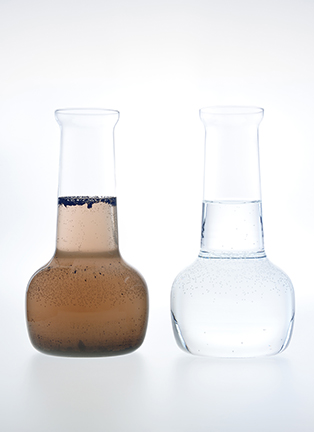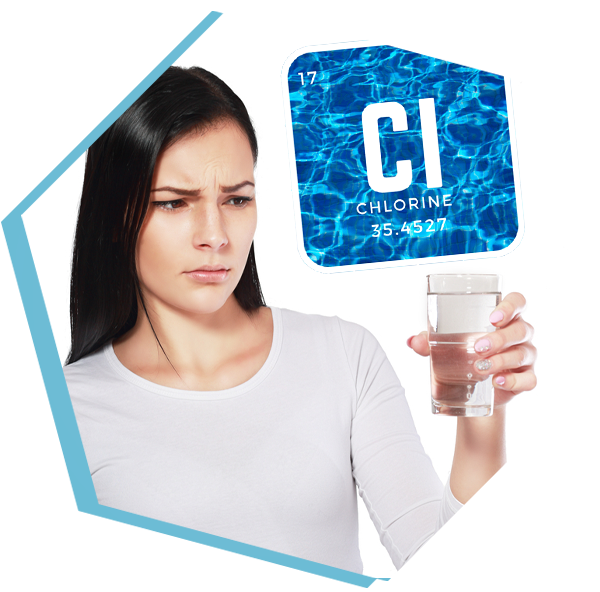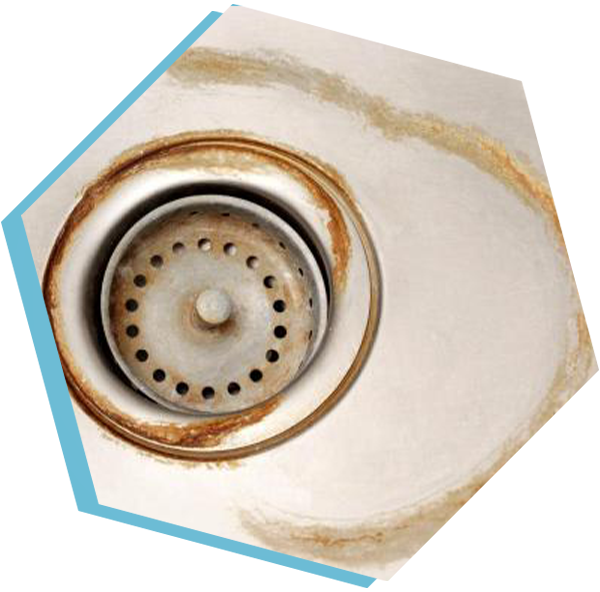Iron
One of the most common problems affecting well water is iron. Iron is the fourth most abundant element in the earth’s crust. As such it is also a common nuisance contaminant in well water. Iron causes brown stains on fixtures and laundry and can clog the insides of pipes and water heaters. While not generally considered a health concern for most people it causes unsightly stains on anything the water touches. Iron drawn from deep wells is generally un-oxidized. That is to say it is not rusted. This is often referred to as clear water iron or ferrous iron. However, when exposed to the oxygen in the air it readily turns to rust. Chemists refer to this as oxidation and the form of iron that results is referred to as ferric iron, red water iron, or oxidized iron. During this transformation from ferrous to ferric iron the iron will react with the other constituents in the water as oxidation occurs. Most often the other relevant constituents are anions or negatively charged ions.
Such anions as alkalinity, sulfates, chlorides, or silica can dramatically affect the type of ferric iron that results. Since iron is a positive ion and the elements just listed are negative ions the two forms will react and create variants of the two as the iron rusts. The form of ferric iron that oxidation produces dictates the various forms of treatment that must be employed if successful treatment is to be done. It is important to note that because of the reactions discussed above two different wells with exactly the same amount of iron but different anions will have different forms of ferric iron produced upon oxidation and hence very different required treatment systems. This is one of the reasons that a good water analysis is mandatory in order to design the best possible treatment systems.
Types of Iron:
For the purpose of removal there are five types of iron as follows:
1. Ferrous iron. Also called clear water iron. This type of iron can only exist in the absence of an oxidant. Such oxidants can be the oxygen in ordinary air, ozone, chlorine or any other oxidizing element. Ferrous iron is un-oxidized iron, sometimes called clear water iron. Completely ferrous iron in water, free of other causes of cloudiness or turbidity, is completely clear. It is possible to have water containing 100 mg/l of completely ferrous iron that is completely clear to the naked eye. Very high quantities of iron can be removed with special types of ion exchange water softeners. The key to success is that ion exchange cannot be employed for high iron removal if any conditions exist that would allow for oxidation of iron to one of the four ferric forms. Upon oxidation the ferrous iron will turn to one of the four ferric or oxidized form of iron listed below.
2. Un-complexed ferric iron. When ferrous iron is oxidized it will form ferric iron. If the water is free of such complications as iron bacteria, tannins and certain other problematic constituents or chemistry the iron will oxidize to a simple oxide. This oxide will be easily filtered with an ordinary iron filter. Often the water will be a mix of ferrous and ferric. In such cases the treatment system must be able to accommodate both species of iron. The advanced technology iron filters available today incorporates technology which allows for removal of both forms of iron without the use of chemicals. This is done by injecting air into the filter bed during the backwash process. The oxygen laden air injected into the filter tank will form an air pocket that the water passes through on its way into the filter bed. As it does so the oxygen will cause the ferrous iron to rust. As the rust contacts the iron filter media it is now in a form that can be mechanically filtered out. Ferrous iron cannot be filtered until it is oxidized. So this aeration process allows for both the removal of ferrous iron and ferric iron in one device. Iron filters equipped with air injection systems are often called air/iron filters. Air/iron filters generally have a limit of 5 mg/l of clear water iron depending on the exact chemistry of the water. Iron levels higher than 5 mg/l will require additional oxidation procedures to insure full oxidation of iron required for filtration. This is sometimes referred to as external oxidation. Typical examples of external oxidation are Chlorination, corona discharge ozoneation, hydrogen peroxide feed or the use of potassium permanganate feed. An older style technique for enhanced oxidation is the use of potassium permanganate batch regeneration of the manganese dioxide filter media. This technique is messy, problematic and generally not completely effective on higher iron containing waters.
3. Iron bacteria. Iron bacteria are non-pathogenic, non-disease causing bacteria. These ancient organism get their energy from the oxidation of ferrous iron to ferric iron. These forms of bacteria are thought to some of the oldest forms of single cell life on earth. They evolved on earth prior to the arrival of photosynthesis and do not rely on other organisms for survival. In effect they are little living oxidizers of iron and other oxidizable compounds. During the oxidation process they create a slimy coating around them. This iron bacteria slime can often be seen in the backs of toilet tanks and hose bibs where water may drip. Over time this slime will build up inside the filter media eventually causing the filter to load with iron bacteria slime and fail to effectively treat the iron. The most advanced air induction filters have as optional equipment the availability of ozone generation systems which during the air injection phase of regeneration inject ozone to suppress and control the growth of iron bacteria inside the filter media. Iron bacteria if not controlled will cause the filter system to fail over time. The ozone generation system is the simplest method of controlling this nuisance. The ozone diminishes once injected into the filter and does not make its way into the house water system. Other more complex methods of controlling iron bacteria are external ozone systems installed in storage tanks or continuous chlorination.
4. Colloidal iron. Colloidal is iron that upon oxidation forms very small stabile particles. The chemistry involved is somewhat complex. Since colloidal iron is generally not present while the iron is in the ferrous form and generally forms only when the iron is exposed to oxidation it is somewhat problematic to predict when and if it will form. The ability to predict such formation is especially important when the consideration of whether or not to install an atmospheric storage tank on an existing well system in and attempt to aid in the treatment of iron. In some cases the addition of an atmospheric storage tank can create more problems than it solves. Prior to consideration of the installation of an atmospheric storage tank it is highly advisable to have a full and complete mineral analysis to determine if colloidal iron formation is likely upon oxidation. Once formed special filters or treatment strategies must be incorporated to remove or prevent the formation of colloidal iron.
5. Organic iron (Heme Iron). Organic iron is iron that upon oxidation chemically combine with tannic acids naturally occurring in the water. Tannins are naturally occurring chemicals derived from organic material such as decaying plant material. Tea is a common example of tannins. Tannins are broken down into various forms. Examples are humic acid, tannic acid, fulvic acid and oleic acid. Some forms of tannins do not create organic iron. Since tannins are organic compounds formed form many different sources they have many different chemical formulas. Some forms cause discolored water and react with iron. Others may be present and nearly colorless while not reacting or minimally reacting with iron. Organic iron treatment is generally site specific and each issue is somewhat unique. In many cases the best approach to organic iron treatment requires site testing with different treatment strategies.
Iron chemistry is more complex than some may realize. However with a good understanding of the chemical processes and with the advantage of a complete water analysis an experienced professional can successfully and in most cases quickly design an effective long term solution to any iron problem.















